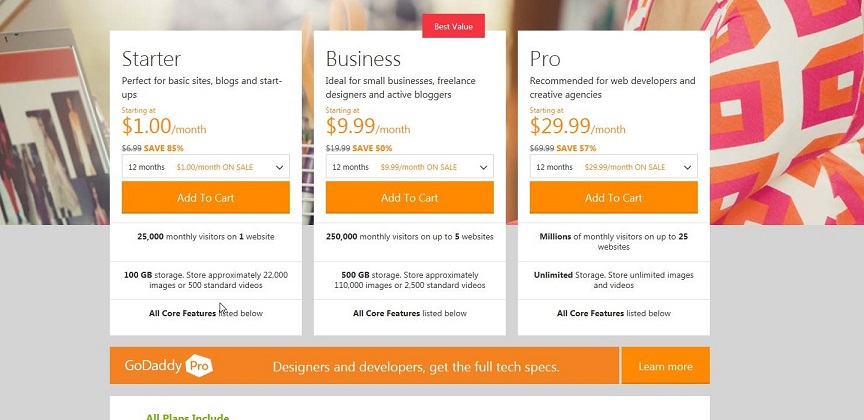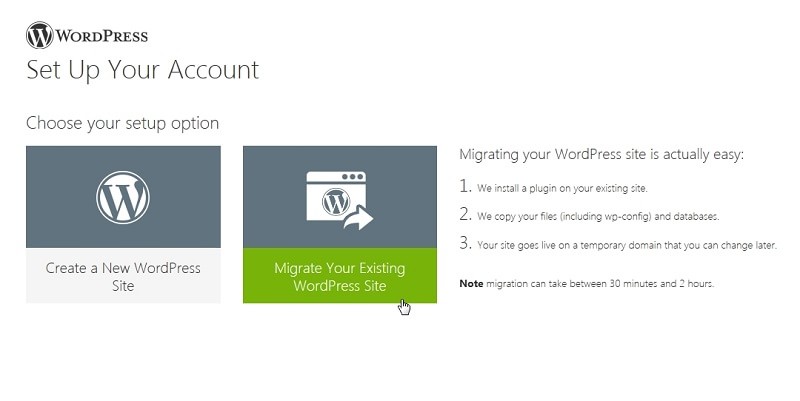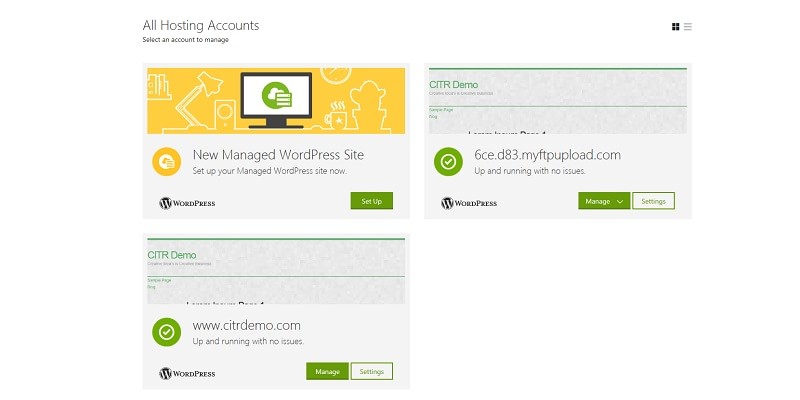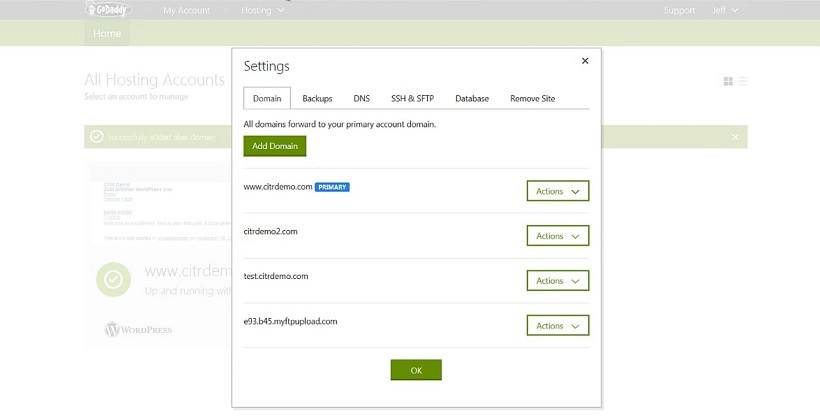What You’ll Learn In This Tutorial
- How to create your GoDaddy Account
- How to buy your first Domain Name
- How to buy your first GoDaddy Hosting Package (WordPress Starter package)
- How to install WordPress
- How to setup your WordPress theme
When you start an online business or perhaps begin your online presence you have to start somewhere. For each of us it begins with finding a website hosting provider. There are so many to choose from such as 1and1.com or bluehost.com. I’ve used 1and1 and GoDaddy for many years and ultimately ended up with GoDaddy exclusively because I felt the customer support was far superior.
GoDaddy offers many hosting solutions for the beginner, intermediate or more advanced needs. Both the beginner or intermediate solutions GoDaddy has what’s called Shared Hosting and Managed WordPress hosting. I’ll deep-dive into these with much more detail in future tutorials but for now Shared Hosting is a shared server using shared resources while Managed WordPress is an optimized environment exclusively for hosting WordPress websites.
Once you have the hosting provider the next step is how are you going to build your website. This question can only be answered by your need. In most scenarios we only want to provide content to some user base by building online credibility with valuable content or by virtual marketing of a product or service you may offer. The other handful of scenarios is to provide an online virtual service only available through a website.
When providing content or marketing a product or service the best option is to use a Content Management System (CMS) such as Joomla, Drupal or WordPress. Each has their place but perhaps the most user-friendly and certainly the largest community is WordPress. Even though WordPress offers their own hosting services (WordPress.com offers hosting, WordPress.org offers themes and plugins) I recommend using a provider such as 1and1, Bluehost or GoDaddy because hosting is their primary business and are a little more tried and true. If you have used WordPress.com to host your site please share your experience with everyone in the comments below. We’d all love to hear them.
I’m a huge fan of WordPress and 100% of my content sites are now managed by WordPress as the CMS. The reason for this is simple; it’s the user community. There is so much information available for self help or customizations available by simply searching Google. WordPress is the backend doing all the heavy lifting allowing you to create pages and posts, displays your content and finally manages site users. On top of all that WordPress allows you to install a theme which is the basis for the look and feel. It then gives you the ability to add and remove plugins which provides features you want your site to offer.
Now that we have narrowed our hosting provider to GoDaddy and our Content Management System to WordPress, let’s quickly compare what GoDaddy has to offer between the Shared Hosting and the Managed WordPress.
First I want to set some general milestones for site growth. Let’s assume in the first 12 months your site goes from 0 visits per day to 1000 visits per day (or 0 visits per month to 31000 visits per month). Depending on your niche it may or may not be very aggressive but I can say 1000 visits per day is more than achievable with some work and could be done in a couple months depending on your skill and level of effort. Then let’s assume your site plateaus a bit in the second year where the growth in comparison is negligible. The idea is we start simple then graduate to a new hosting level.
As of today, GoDaddy offers the following entry level and intermediate level hosting packages:
- Managed WordPress
- Starter (entry level)
- Business (intermediate level)
- Shared Hosting
- Economy (entry level)
- Deluxe (intermediate level)
Like most things we start low and scale with demand. It might seem obvious to begin with the Starter or Economy then graduate to the Business or the Deluxe. In fact, that’s exactly what I do because I know the first month or maybe three I’m only creating content with no focus on Search Engine Optimization (SEO) or other traffic generating methods.
It then becomes important to know GoDaddy is very flexible when upgrading accounts. The truth of the matter is, not only does GoDaddy make more money if you upgrade but they also know your site traffic will grow and therefore an upgrade is a service they must provide. Sounds great right? Well before you buy 36 months of the Starter Managed WordPress at $1/month you need to know if you upgrade at month 13 to the Business Managed WordPress you must pay 24 months of the Business at $9.99/month less the 24 month credit for the Starter Managed WordPress of $24. That was a mouth full. Basically, if you do an upgrade, the upgrade will be for the remainder of the original term purchased. In this example if you buy 36 months and upgrade at the start of month 13, the duration of the upgrade will be for 24 months minus a credit from the original purchase. But in all reality, if you’re doing 1000 visits per month $228 should be a drop in the bucket.
There’s one last catch to upgrading. When upgrading GoDaddy cancels one hosting package then creates the new hosting package. It’s important to communicate this to GoDaddy so they can assist with the upgrade so you aren’t left with the complexity of copying files and moving databases. You might need a brief overlap to make the migration. The Managed WordPress hosting makes moving a site about as painless as possible using their Site Migration feature.
Now, do you start with the Economy or the Starter hosting package? The answer to that question is in the next several tutorials, but here are a few tips to help you decide. If you need email hosted and don’t want to use Gmail, Yahoo! or your ISP email then the Economy is a must. The Economy gives you the ability to send and receive email using your domain name with a POP email server. The Starter on the other hand only allows you to receive email using your domain name by forwarding to your primary email account. Beyond that the Starter is definitely what way to go.
By the way, a GREAT alternative to email is Office 365 for Business. I love Office 365 and use it extensively. If you are not familiar with Office 365 it’s Google Drive on steroids by offering email, Microsoft Office online, the latest version of Microsoft Office, OneDrive and SharePoint.
When you’re ready to upgrade the same still applies in regards to email between the Deluxe and the Business hosting packages. The Business only allows for email forwarding to your primary email account. The Deluxe sounds like a great solution with unlimited bandwidth and unlimited storage but you are still limited for resources such as memory, CPU usage and number of files. The Business is a great option for upgrading because you are allowed five site, which doesn’t interest me much. But what does interest me is the Staging feature. I’ll be covering this is great detail in a not so distant tutorial, but the short explanation is you have the ability to copy your site, work on it and when you are ready you can copy/replace the staging site to your production site. As you become familiar with WordPress, this is a pain point for managing your WordPress site which is solved by this simple GoDaddy feature. The Deluxe is a great sandbox solution for hosting a large number of WordPress sites. Too much traffic and every site suffers. I use the Deluxe hosting to build sites for clients and can have up to 5 or 15 develop0ment sites at any given moment. When the client is ready they have a Starter or Business hosting and the site is migrated over with the Migration tool.
Links and Resources Used In This Tutorial
- GoDaddy
- GoDaddy new customer discount
- WordPress.org – Themes and Plugins
- WordPress.com – WordPress Hosting
- WordPress Limit Login Attempts
- BLOG: Top WordPress Plugins
- Office 365 for Business Plan Comparisons
Thanks For Watching!!
There was a lot of information for getting started with your first GoDaddy WordPress website. So don’t hesitate to share thoughts or ask questions in the comments below. I read all the comments and will always respond with my best answer.
Thanks for watching and more than anything I hope you found this helpful.
If you enjoyed this episode be sure to share it, like it, subscribe or whatever. Spreading the word helps and means a lot. Thank you!












However, most powerful feature of WordPress is its extensibility, which comes from plugins. There are thousands of WordPress plugins that allow you to do almost anything imaginable.